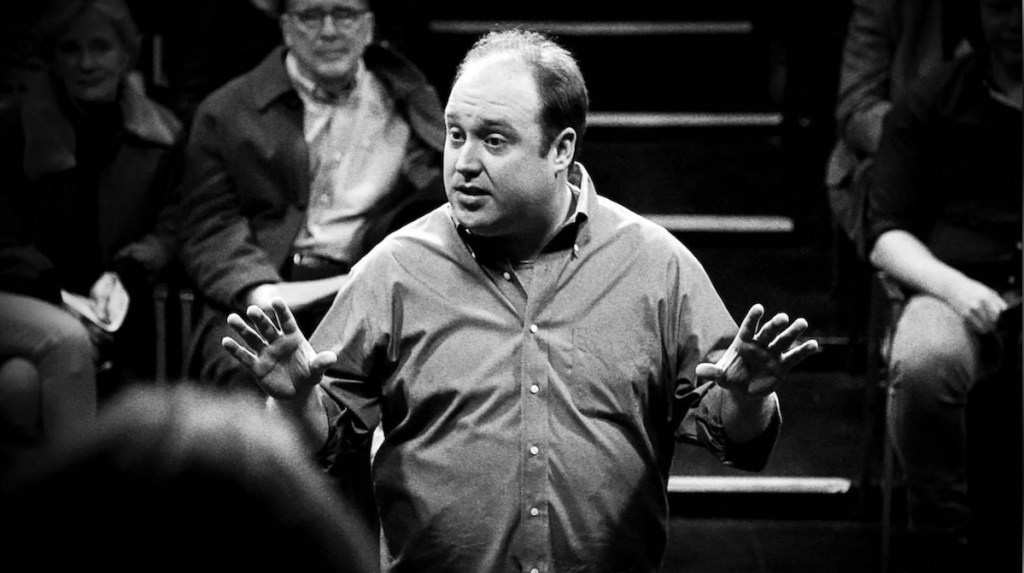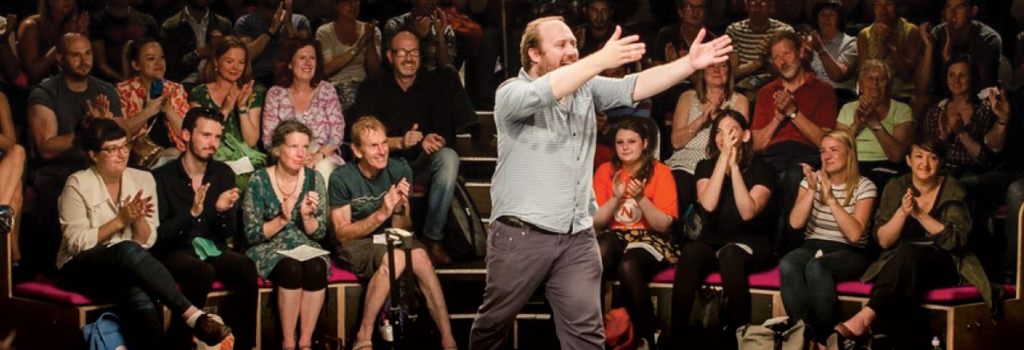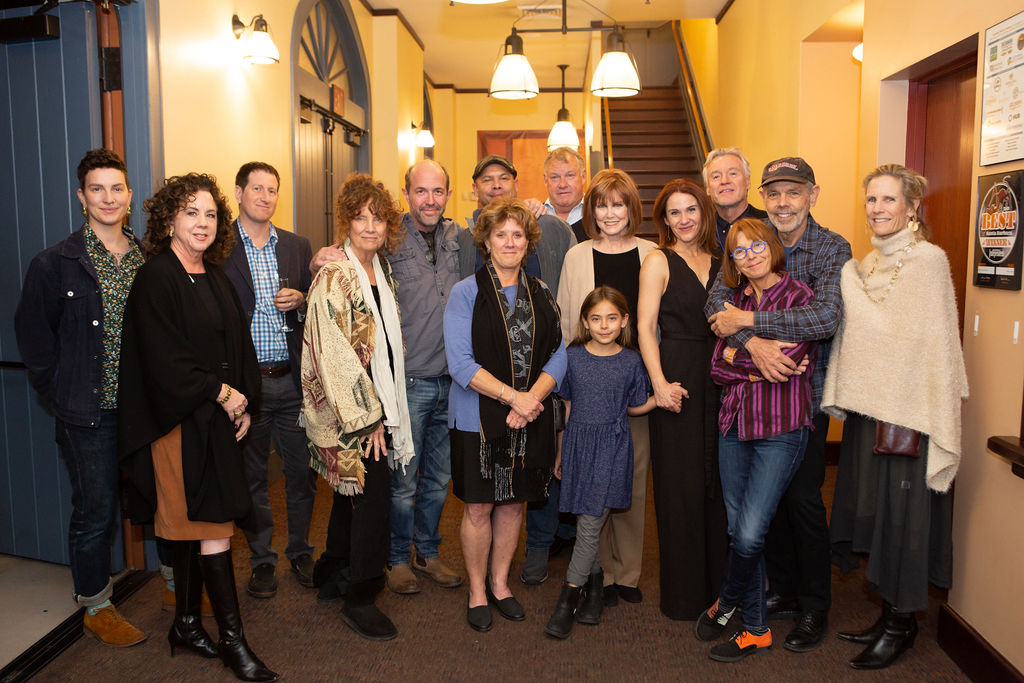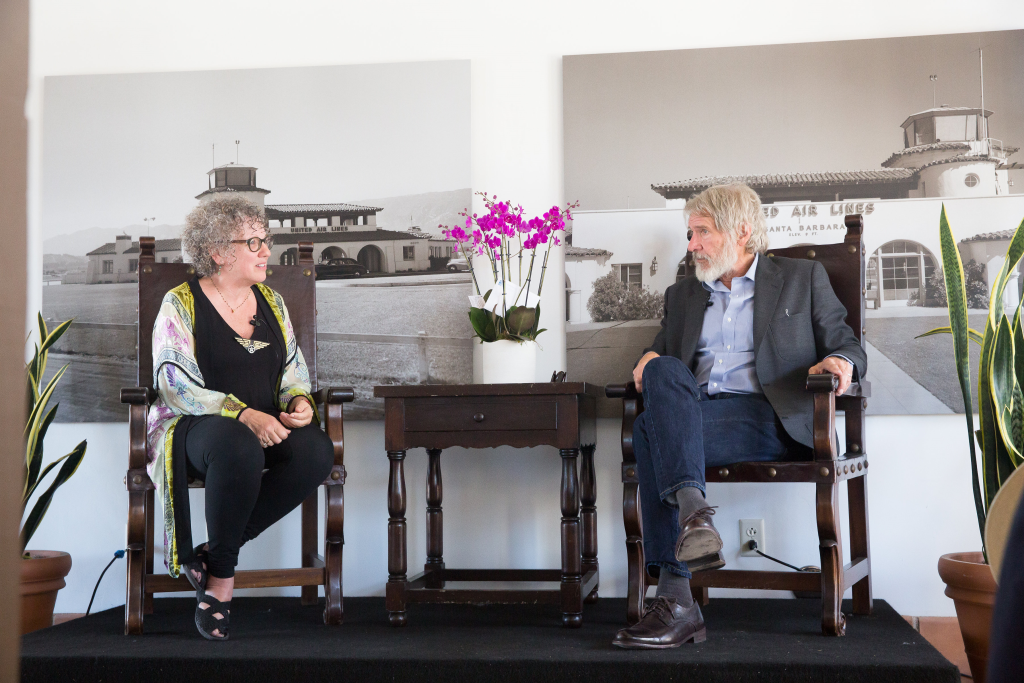Art, Activism, and
Every Brilliant Thing
Groundbreaking One-Man Show Brings
Entertaining, Compassionate Focus
to Mental Health Issues
By Josef Woodard | September 8, 2022

Technically, the British play Every Brilliant Thing is a one-man show, an acclaimed tour de force achievement by British comedian Jonny Donahoe, who inspires tears and laughter over the course of 75 minutes of inventive theater. But when the play lands in Santa Barbara’s Center Stage Theater (Sept. 23-25), audiences will quickly learn that the literal one-man show description is at least marginally incomplete.
For one, audience participation reaches new heights of interactivity in the clever structural design of the play. More tellingly — and yet more abstractly — the play’s unseen character is a huge, quietly looming specter: a suicidal mother character and, by extension, the vast, broadly relevant topic of mental illness and its effect on both victims and family members. Those entities loom in the wings. And yet, somehow, the play works a delicate balancing act of lightness and compassion.
Heralded as a sensation in London, off-Broadway, and streaming via a 2018 HBO special, the play, written by Duncan Macmillan with Donahoe, makes its Santa Barbara premiere with a fitting benefactor, as a fundraiser for New Beginnings Counseling Center.
In Silver Linings Playbook, one of the more prominent Hollywood films dealing with mental illness (and inspired by director David O. Russell’s experience raising a bipolar son), our protagonist (Bradley Cooper) measures baby steps of success in grappling with bipolar condition by noting successful moments in a figurative playbook.
In Every Brilliant Thing, our protagonist, trying to bring life-affirmation to both his depressed mother and himself, creates an expanding list of “brilliant things” to make life worth living. On that list, which he starts at age 7 after his mother’s first suicide attempt and continues through his own depression-flecked adult life, are such nuggets as “kung fu movies,” “Laughing so hard you shoot milk out your nose,” and “Marlon Brando.” The audience is folded into the process, having been passed out cards and asked to read the life-affirmative “things,” and sometimes asked to play roles — a father, a girlfriend — in the evolving life of our protagonist.
Key lines jump out of the play’s rolling text and fluid narrative, as when Donahoe suddenly utters a core value and message of the play we’re watching: “Advice to suicidal people: Don’t do it. Things get better.” From an empathetic angle, he also suggests, “If you make it to old age and you haven’t been crushingly depressed, then you probably haven’t lived.”
Kristine Schwarz, executive director of New Beginnings, points out that “subjects like trauma, grief, depression, and loneliness can be very isolating and often make it difficult for a person to articulate what they are feeling, and sometimes it is easier to express heavy emotions when we become — or ‘play at’ — being someone else, or by using music or drawing or an artistic depiction to communicate a profoundly overwhelming emotion. Somehow that makes it easier for others to be empathic. It can get people to think in a different way about the issue of mental health, or homelessness.
In considering the juncture of art and mental distress, it’s important to recognize that mental illness, in varying forms and degrees, has been woven into the very fabric of the creative process and of making art, throughout history. Schwarz notes, “The arts and entertainment have always been an effective way for those who suffer from mental illness to express themselves — van Gogh, Virginia Woolf, Frida Kahlo, Charles Dickens, Sylvia Plath, Picasso, Tim Burton, Woody Allen, Anthony Bourdain, etc. It is healing for some to share and help others in the process, (to make) post-traumatic growth.”
Eyeing Mental Illness through the
Comi-tragic Lens of Jonny Donahoe

I was so impressed, on multiple levels, with the televised version of Every Brilliant Thing. I don’t believe I’ve ever experienced anything quite like it, in terms of its structure, audience engagement, and deft balancing of tragedy and comedy — not to mention showcasing the subjects of depression and suicide. Would you say this piece has changed your life, and do you see it as a theatrical experiment with a deep heart?
Jonny Donahoe: It has definitely changed my life, and it’s very good of you to say such nice things about it. The show has such a “deep heart,” as you so kindly put it, I think because of the gravity of the subject matter. To talk about suicide onstage is so vital, and yet also could be dangerous if it was incorrectly handled.
So we had to work and work and work at that to get it right and strike that balance. The audience engagement was an obvious theatrical thing to do for us. The first step you need to take to help yourself in a depression is to reach out, to share, and to commune, so we felt we had to make that happen with the audience live in the show.
This television version was shot in 2018, after you were already deep into the play’s runs in the U.K. and New York. How has the piece evolved for you, especially in the gap between then and now, after the hollow chasm of the pandemic? Is there a new depth to the experience of performing it now? Well, this will be the first time I’ve performed it since the pandemic, so I’ll find out how that has changed the nature of the play and the audiences’ reactions. But I have found that, since we were all locked down, the very act of performing on a stage in front of an audience is an even deeper, more resonant and cathartic act for everyone — performer and audience. That was noticeably the case when I performed other shows earlier this year. I can only imagine it’ll be more so with Every Brilliant Thing.
As a central aspect of the piece, you really do interact with and feed off of the crowd in the round (love that scene with you singing as your keyboard is revolving). Is that always a refreshing element in each performance, and do you feel your work as a comedian has enhanced your natural ability to “work the crowd?” One intention of the show — a very long time ago when we were first making it — was to try to make something that would combine the very “live” and spontaneous style of a stand-up or improv performer, alongside the more technical, nuanced skills of a proper, real stage actor — to try to get the best of both worlds in one show.
I knew a great deal less about real stage acting than I did about stand-up at the start, so it made sense to use the skills I had. I do think the improvisation and changes made every night keep the show very fresh and alive, and that makes it a better experience for everyone.
Obviously, this is a project that both entertains and deals creatively with the pressing — and universal — issue of depression. Post-pandemic, the prevalence of mental illness, anxieties on different levels, has become even more an issue, globally. Do you have general thoughts about the potential interaction and therapeutic powers of the arts — theater, film, and beyond — and mental illness as a subject? I think in the seven or so years since I first performed this show and now, the world has changed dramatically. We seem now to be able and willing to talk more about mental health, and mental illness as a society, and we seem to have become more understanding of this issue. We appear in some ways to be better at talking, listening, helping…. But we’ve only chipped at the surface. There’s so much more to be done, and that’s one of the reasons I wanted to be performing this show again.
Your Santa Barbara performance will benefit a worthy cause, New Beginnings Counseling Center. Is it gratifying to be able to directly impact and help organizations such as this in the line of your theatrical duty? Does it involve a sense of helping out at a ground level? Organizations like New Beginnings do such amazing work, and it’s very special for me to be able to do something that’s in any way beneficial to the charity and the people they work with. I’m just a silly comedian, really — and I don’t always have the skillset to do “ground-level” work, nor the patience or any of the other things needed to do such important work. Sometimes, you can feel a bit selfish just making theater, even if the work is about trying to help people. So this is a very special, important run of shows for me.
After such a long investment in the intense world of Every Brilliant Thing, do you have a desire to lighten the load with acting or comedy projects of a more frivolous kind? I keep meaning to do that — just make something silly and fun. But you look out the window or catch the news and it’s hard to stay frivolous. When we’ve solved climate change, the number of children living beneath the poverty line, the mental health crisis, and Trump is in prison, maybe I can make a show about ice-cream and dancing. That’s a good aim for the future.
For more information and to purchase tickets for the fundraiser, visit:
https://sbnbcc.org/benefit-september-2022/
50 Years of Changing Lives at New Beginnings Counseling Center

With a track record exceeding half a century, the New Beginnings Counseling Center (sbnbcc.org) qualifies as an anchoring presence in Santa Barbara’s mental wellness field. Its worthy-cause status is well-established. Hosting the famed Every Brilliant Thing, featuring its dynamic originator onstage dealing directly with the subject of mental illness, amounts to a beautiful, beneficial case of synergy.
But the arts and arts-related philanthropic entities have long been a part of the New Beginnings world. It all began with a surprisingly popular screening of the documentary Skid Row Marathon, about Los Angeles judge Craig Mitchell, who launched a running club for homeless people, addicts, and others sentenced to Skid Row. After the success of that event, New Beginnings Executive Director Kristine Schwarz said the Center “decided to embrace a new approach for our annual fundraiser where we utilized the arts and entertainment to engage with and educate our community about the critical issues we address in our work.”

Since then, the Center has enlisted the help and dialogue from actors and arts-related visitors including Harrison Ford, Julie Bowen, and Annabelle Gurwitch, and produced a Jane Anderson play at the New Vic, all helping to draw awareness and generate fundraising for the center.
Zooming up to this year’s stellar fundraising event, Schwarz says, “In 2020, I was researching the subject of mental illness for our next event and came across Every Brilliant Thing and watched the documentary while the play was running off-Broadway, and I knew immediately that this was our next event. Unfortunately, COVID had other plans, but we are now finally able to bring Jonny to Santa Barbara after almost three years in the planning.
“This is definitely not a customary way of talking about homelessness and mental illness necessarily, but each event has brought more and more community members to our organization and increased their understanding of these issues.”
Special public events and celebrity guests aside, the year-round, day-to-day focus of the center’s efforts puts a special emphasis on working with an underserved clientele, in need of help but lacking financial resources to pursue it via conventional avenues. Making services available to those who can or can’t afford it, New Beginnings describes itself as “a nonprofit that provides low-barrier mental health counseling, as well as supportive services for families, youth, individuals, aging adults and veterans; we are on a mission to help destigmatize mental health care and ensure it is accessible to all.”
An all-volunteer team of counselors and clinical supervisors ensures that counseling sessions run an average of only $13.
The Center’s services are more critical than ever at the moment. Schwarz says, “We have seen an unprecedented presentation of increased distress and a decrease in distress tolerance since the start of COVID. Services need to be accessible and affordable and equitable. There are a number of community partners and collaboratives we work with who are working to increase access, through such organizations as YouthWell, the Mental Health Advisory Board, Be Well, Cottage Hospital, Mission Harbor Behavioral Health, Santa Barbara Neighborhood Clinics, and CenCal.”

Art therapies are also entrenched in the Center’s list of projects and objectives. These include drawing, painting, collage, journaling, poetry, and fStop Foundation, a digital photography workshop created by former board member Terence Ford for First Responders and Veterans.
“Jonny also shows us how important and necessary and normal it is to want to talk about depression — how important interdependence is to our well-being. That it’s okay to have emotions about stuff that is really challenging and scary and painful, and it can help to feel better if you talk about it. And learning that through a story about someone you can relate to, connecting to the public through the arts in this way, is somehow anonymous and safe — and, in this instance, bonding and compelling.”
Circling back to the essential message and method of Every Brilliant Thing, Schwarz says, “Most of us have experienced grief and rejection and fear, especially like in some of the situations depicted within the context of this play. Jonny’s reflections about depression and suicide and his resulting interactions with the audience are surprisingly funny without being irreverent or political or stigmatizing. There is a tenderness to his handling of the subject that the audience appreciates and respects.
Additional resources about suicide and depression:
https://www.countyofsb.org/559/Suicide-Awareness-Prevention
https://211santabarbaracounty.org/mental-wellness/hotlines/suicide-prevention-hotlines
https://www.namisantabarbara.org/
Mental Wellness Center’s 75 Years of Service

Mental Wellness Center client and peer arts teacher Lesley Grogan at the Mental Health Arts Festival with her art display. | Credit: Carla Amurao (file)
In one of the many signs of life and cultural calendars in Santa Barbara returning to a regularly scheduled programming, De la Guerra Plaza recently played host to a long-standing tradition, the Mental Health Arts Festival, a flagship event for the Mental Wellness Center (mentalwellnesscenter.org). In its 26th iteration, the festival once again served as a centrally located and very public display of the fruits of art therapy, deployed by many mental-health services in town but with an inspiring “street” presence in town.
Apart from the annual exhibition’s literal public visibility, the tradition shows up in other forms, as it did through director Justin Rowe’s documentary Crazy Art, an Audience Choice Award–winning film screened at the 2010 Santa Barbara International Film Festival. Three of the schizophrenic artists profiled in the film — Rodger Casier, Trinaty Lopez Wakefield, and Lesley Grogan — were festival-featured artists.
Postponed during the pandemic, the return of the festival’s feast of art by patients and clients of the Mental Wellness Center (MWC) also provided a reminder of the increased attention on mental illness in the current stress-infused global environment.
As the Center’s seasoned CEO Annmarie Cameron explains, the festival is “a much-anticipated event for the artists who participate in it. Beyond just being an arts festival, this event offers a unique opportunity for individuals living with mental illness to exhibit their creative talents, enhance their self-esteem, and be perceived as worthy and valuable members of our community.”
“All too often, people living with mental illness are marginalized and not seen,” she said. “While others may focus on their differences or limitations, MWC chooses to see their attributes, their strengths and their resilience despite the often enormous odds against them.”
Creative approaches to therapy and creative activities are central to the agenda of the MWC, now 75 years old, including art workshops at its Fellowship Club and weekly drum circles.
Cameron believes that “creative work benefits many, if not all, people. Studies show that music, painting, and other material art forms contribute to brain functioning, not just for children but also for adults. The physical act of craftsmanship can be calming and help with anxiety and depression. For people battling internal voices, engaging in art puts those voices in the background, offering a brief respite. Creative work also allows people to access trauma when they have no words. In short, art helps form a road map or vision that can advance recovery from mental illness.”
The Artistic Groundbreaker: Access Theater

Credit: Courtesy
In the annals of Santa Barbara–based theater concerned with, and populated by, marginalized communities, the name Access Theater looms large, with a reputation extending well beyond city limits. Formed in 1979 by founder and director Rod Lathim, the company — starting humbly as an all-volunteer group but elevating into a nationally known equity group — was an intrepid organization daring to engage and employ actors with disabilities and to actively develop “accessible” theater practices.
Lathim says, “We were created to be a fully accessible theater, which meant that our doors were open to all people, regardless of disability or having no disability. We worked primarily with people who happened to have physical disabilities and actors who were deaf, as well as able-bodied and hearing actors.”
“We had a wonderful 18-year run,” Lathim says. The highlight was the play Storm Reading, which began its life in 1988 at the Lobero Theatre and ended up touring internationally for six years, giving Access Theater a national and global spotlight unprecedented in Santa Barbara theater history. A special 30-year anniversary of Storm Reading was presented at the Lobero in 2018, including original cast members Neil Marcus, Matthew Ingersoll, and Kathryn Voice.

As Lathim notes, “Storm Reading is a classic example of how theater can impact people’s emotional and mental health. The show was enlightening, to say the least. It dispelled so many stereotypes and opened the minds of every audience it performed for. We received countless letters from people sharing their stories of how the show changed them through giving them new perspectives on their own lives and on those living with disabilities. Although Neil [Marcus] had a severe disability [dystonia] and had difficulty speaking, his incredible spirit blasted through and touched people. He was a role model of living one’s true self.”
Speaking more broadly about the expressive and therapeutic powers of theater, especially in dealing with rarely broached subjects and communities, Lathim says, “I truly believe that theater can impact emotional and mental health in its audiences. Part of what made Access Theater wonderful and unique for me was that we were telling authentic human stories. Our civilization is built on storytelling to pass on cultures and practices and myths. Theater is such a magical platform to touch people face-to-face in a live setting. This is something that our culture is rapidly losing thanks to technology.”




You must be logged in to post a comment.